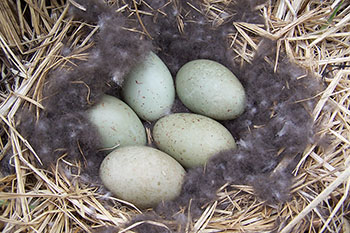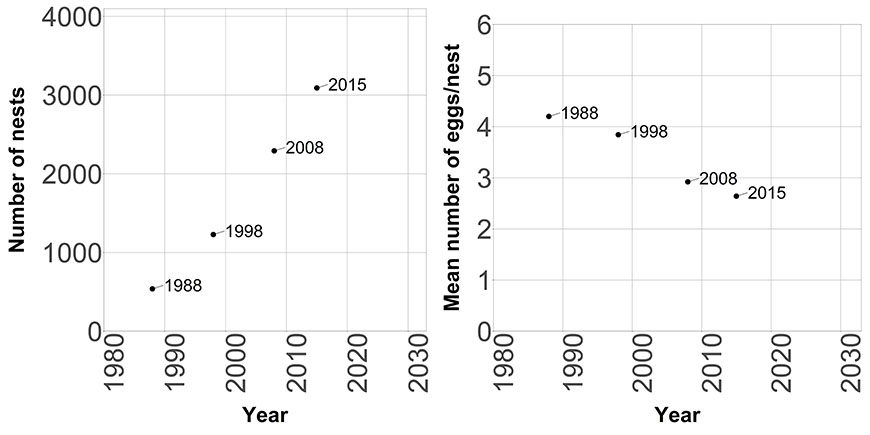Eider Duck
Mingan Archipelago National Park Reserve
Loving Minganie like the eiders love their nests

Common eiders (Somateria mollissima) nest by the thousands in the barrens and forests of the Mingan Archipelago National Park Reserve. The eider populations in the archipelago are among the largest in the Gulf of St.Lawrence. Under the Ecological Integrity Monitoring Program, the state of eider populations is one of the measures used to evaluate the health of the barrens in the Mingan Archipelago National Park Reserve. Two parameters are measured:
- Number of nests;
- Average number of eggs/nest.
An inventory of eider nests and eggs is conducted in the barrens every 10 years. It takes place from late May to early June. Advancing forward side by side,the inventory takers cover all of the sedimentary islands dominated by thebarrens in search of nests.
More nests but fewer eggs
In 2015, 3,090 eider nests were counted in the barrens of the inventoried islands (figure 1). The rising trend observed since the 1988 inventory has continued to maintain itself. These increases observed in the Mingan Archipelago National Park Reserve and in other migratory bird sanctuaries on the North Shore contrast with those observed along the northeast coast of the US. In fact, this region of the Atlantic coast has seen a significant decline in eider nesting populations due to factors that are still difficult to pinpoint.
However, the average size of eider clutches has been decreasing in the barrens of the Mingan Archipelago National Park Reserve. In 2015, there was an estimated average of 2.64 eggs/nest. In 1988, the average was 4.20 eggs/nest, which translated into a healthy population. Many factors can have an impact on the size of eider clutches including the age and weight of females, nesting habitat, egg laying phenology, competition for limited resources (food for example), predation, egg gathering, weather, etc. We therefore have to interpret this decrease in clutch size with caution given that we currently have little additional information regarding the ecological factors that have influenced the situation.
Figure 1: Number of eider nests and eggs at the Mingan Archipelago National Park Reserve between 1988 and 2015

Figure 1 - Text version
- Number of nests
- 1988: 538 nests
- 1998: 1,228 nests
- 2008: 2,291 nests
- 2015: 3,090 nests
- Average number of eggs/nest
- 1988: 4.20 eggs/nest
- 1998: 3.84 eggs/nest
- 2008: 2.92 eggs/nest
- 2015: 2.64 eggs/nest
State deemed fair but improving
Combining the number of nests with the size of clutches, the state of nesting eider populations in 2015 was deemed “fair” with a trend towards “improvement”.
The next eider inventory in the barrens will take place in 2025. The results are eagerly anticipated since they will confirm or rebut the trends observed in 2015. A forest inventory of eiders is planned for 2021. This will make it possible to compare the eiders nesting inthe barrens with those nesting in the forest and to nuance the interpretation of the 2015 findings.
Until then, let’s hope the eiders continue to come by the thousand to nest in the barrens of the archipelago so as to convey their attachment to the Minganie region to their offspring!
Author
Marie-Claude Roy, Ecologist Team Leader, Mingan Archipelago National Park Reserve.
References
Chapdelaine et al. 1986. Eiders in Canada. Canadian Wildlife Service.
Christine Lepage, personal communication 2019.
Quote
Roy, M.-C. 2020. Loving Minganie Like the Eiders Love their Nests: the state of Common Eiders in the barrens of the Mingan Archipelago National Park Reserve in 2015. The Conservation Chronicles. Parks Canada. August 2020
Related links
- Date modified :